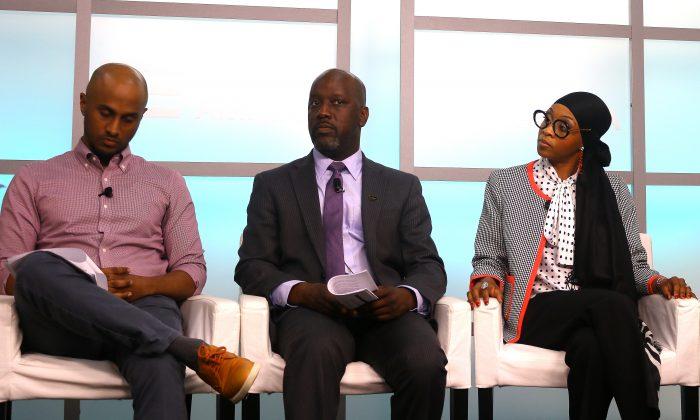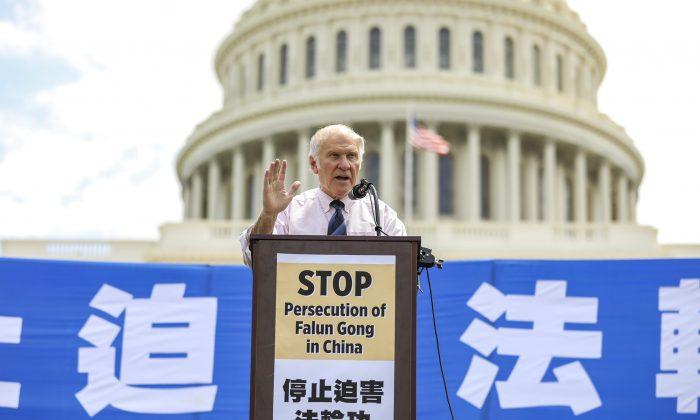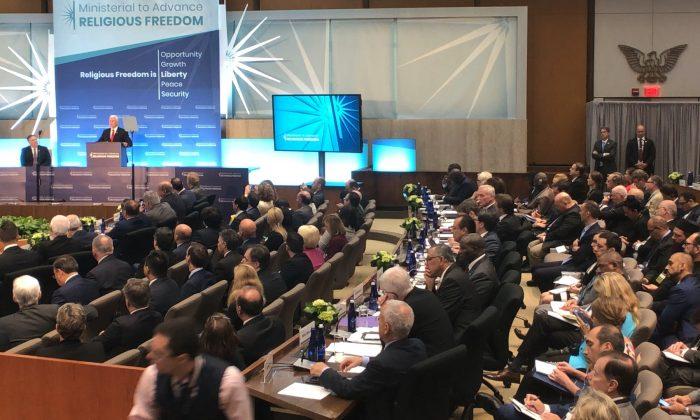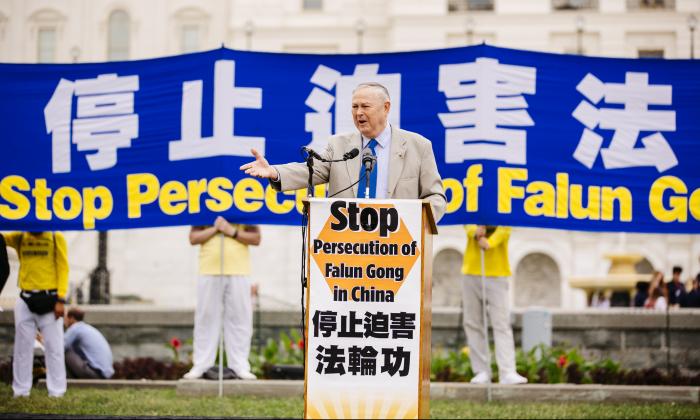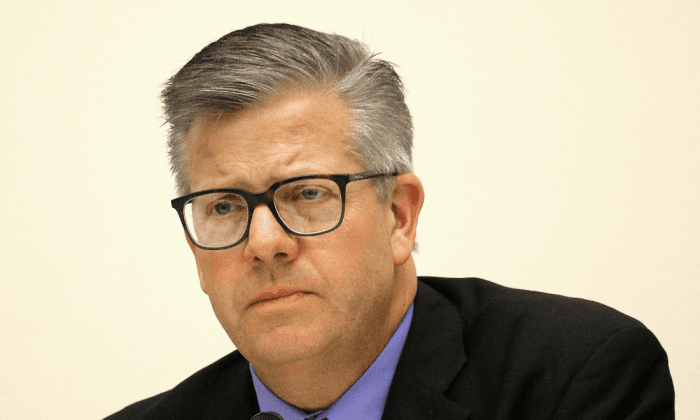WASHINGTON—In a speech on May 4 at Lehman College, West Bronx, New York, President Barack Obama said that long after he has left the office of the presidency, the initiative he started a little more than a year ago will continue to be working toward the removal of opportunity gaps that young people face, particularly young people of color.
“My Brother’s Keeper Alliance” is a nonprofit organization of private sector organizations and companies that work with experts and hard data to identify the barriers and find creative ways to remove them.
“You all know the numbers. By almost every measure, the life chances of the average young man of color is worse than his peers. Those opportunity gaps begin early – often at birth – and they compound over time, becoming harder and harder to bridge … And that sense of unfairness and of powerlessness, of people not hearing their voices, that’s helped fuel some of the protests that we’ve seen in places like Baltimore, and Ferguson, and right here in New York,” Obama said.
Three days later on May 7, the New America Foundation in collaboration with Howard University, held a forum on “The Criminalization of Black Youth in America” that focused on critical factors affecting life chances: school discipline, zero tolerance policies, more police presence in schools, and the increasing number of arrests and referrals to law enforcement.
The speakers wanted to address what has come to be known as the “school-to prison pipeline,” which can have long-life negative consequences.
School Suspensions, Arrests
In March 2014, the U.S. Department of Education’s Office for Civil Rights released a report that revealed disturbing data—some of it was quite shocking—concerning school discipline policies around the country. The Civil Rights Data Collection (CRDC) found that students of certain racial groups or with disabilities are disciplined at much higher rates than their peers, and the differences show up beginning in preschool.
“Black students are suspended and expelled at a rate three times greater than white students,” it says. CRDC also reported that black students represent 16 percent of student enrollment, but 27 percent of the students referred to law enforcement and 31 percent of students to a school-related arrest.
The majority of suspensions are with boys, which can hide a still greater racial disparity between black and white girls. New research by the African American Policy Forum (AAPF) and Columbia Law School’s Center for Intersectionality and Social Policy Studies suggests that black girls from Boston and New York City are suspended from school six times more often than white girls.
Thomas Mariadason, staff attorney with the Advancement Project, gave some illustrations discussed in the media of a school discipline issue elevated to outside law enforcement. In 2013, in Polk County, Fla., 16-year-old Kiera Wilmot, a student with good grades, conducted a science experiment before school that resulted in a small explosion and some smoke. No one was hurt. The county school authorities had her charged with a felony—possessing and discharging a weapon on school grounds. Although the charges were later dropped, she had to complete her high school degree through the expulsion program.
Consider suspension of preschoolers. Nearly half (48 percent) of preschool children receiving more than one out-of-school suspension were black children, who make up 18 percent of the preschool enrollment. The pattern continues all the way up through high school.
Mariadason referred to a kindergartner in St. Petersburg, Fla., in 2005, a black 5-year-old girl, who had a temper tantrum, and pulled some items off the bulletin board, and hit the assistant principal. Mariadason said, “Instead of using common sense,” the school called the police, and three police officers came and handcuffed her, to the dismay of her mother and some news media.
The president said, Feb. 27, 2014, when he first introduced “My Brother’s Keep” Initiative, that if a student has been suspended even once by the 9th grade, he is twice as likely to drop out.
“That’s why my administration has been working with schools on alternatives to the so-called ‘zero tolerance’ guidelines – not because teachers or administrators or fellow students should have to put up with bad behavior, but because there are ways to modify bad behavior that lead to good behavior – as opposed to bad behavior out of school. We can make classrooms good places for learning for everybody without jeopardizing a child’s future,” Obama said.
Math teacher, blogger, speaker, and activist in New York City, Jose Vilson, said the problems stems from the mistaken belief that if kids do exactly as the teacher says, they will learn very well as reflected in test scores. “People have exacerbated this to the point that every move you make, or not make, is an issue of criminality. So you can be suspended for having the wrong dress code… or the slightest infraction.”
Vilson, who is the author of “This Is Not A Test: A New Narrative on Race, Class, and the Future of Education,“ said that people assume this is happening in only places like Mississippi and Arkansas. ”No, it’s happening in New York City, it’s happening in places we call liberal.”
Later Vilson pointed out that the deplorable handling of discipline is not just white teachers, but black teachers as well. As a teacher himself, he says he hears his colleagues refer to “those kids” as if apart from themselves. He prefers to think of unruly kids as “our kids.”
One factor contributing to this social distance may be fear. Dr. Bahiyyah Muhammad, assistant professor of Criminology, Howard University, said that her research uncovered a great deal of fear among teachers. Based on focus groups, she urged teachers and students to have conversations so they see each other as human beings. Students are not aware that teachers are often fearful of them.
School-To-Prison Pipeline
The eagerness to arrest leads to more convictions and imprisonment. The school-to-prison pipeline is a reality for students of color. Obama said last year, “If a student gets arrested, he’s almost twice as likely to drop out of school. By making sure our criminal justice system doesn’t just function as a pipeline from underfunded schools to overcrowded jails, we can help young men of color stay out of prison, stay out of jail.”
One factor not sufficiently appreciated, said Dr. Muhammad, is the rhetoric that people believe in the black community that a young man going to prison is a rite of passage in order to learn to become a man. “It’s not,” she said emphatically. Unfortunately, this language of rite of passage is not contradicted by parents.
The rhetoric used now regarding going to prison or school discipline is not questioned by the parents, and determines the negative way they think and talk, she says.
Human Development vs. Criminalization
Mariadason said that teachers and school resources rely on police when they can’t manage a classroom and more school arrests occur. The school codes increasingly contain language taken from the criminal justice system. What was before “a fight” becomes “probable cause” for an arrest, he said.
Toward a solution to this trend, Ed Davies, executive director, DC Trust, said that the teachers and administrators need to “engage and interact with young people from a positive human development approach,” something much broader than just discipline in the classroom.
If we can make a decision based on just a view of someone’s skin [and] ethnicity, it shows us how far removed we are from seeing young people as being human,” he said.
Vilson said he often sees an effort to find a solution by the hire of a male teacher of color, “not as an educator but as an overseer.” He says this entirely misses the point that the task for the teacher is to make people better in the sense that Davies spoke of.
Vilson said, “A preschooler is arrested, to take the joy out of a child just because you want better test scores, or you just want zero tolerance to set an example.”
He continued, “The examples turn out to be kids of color.”
